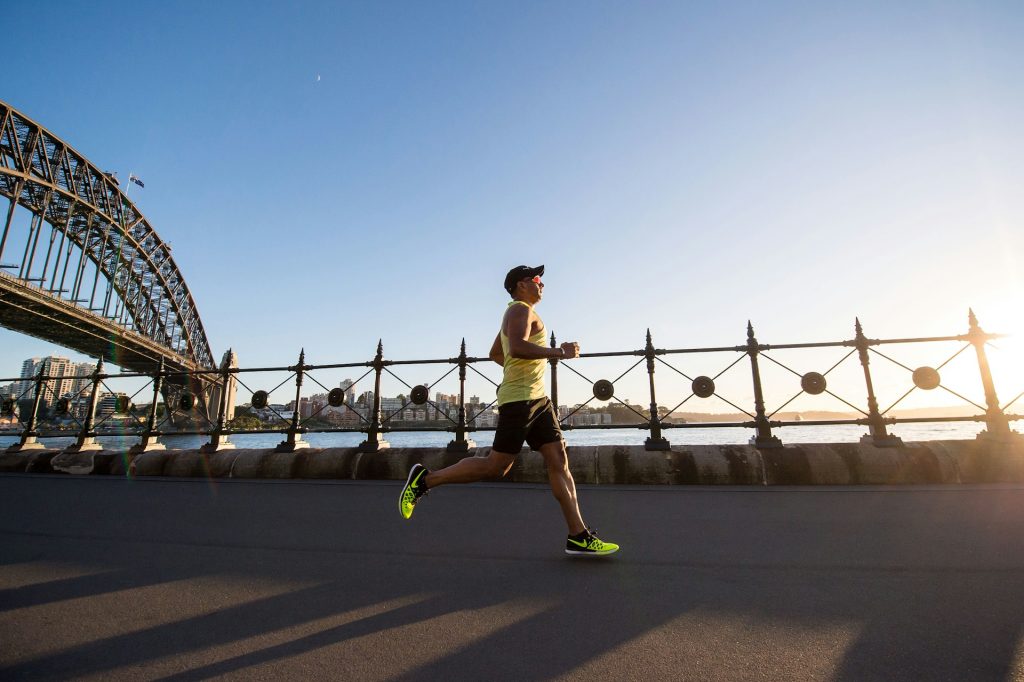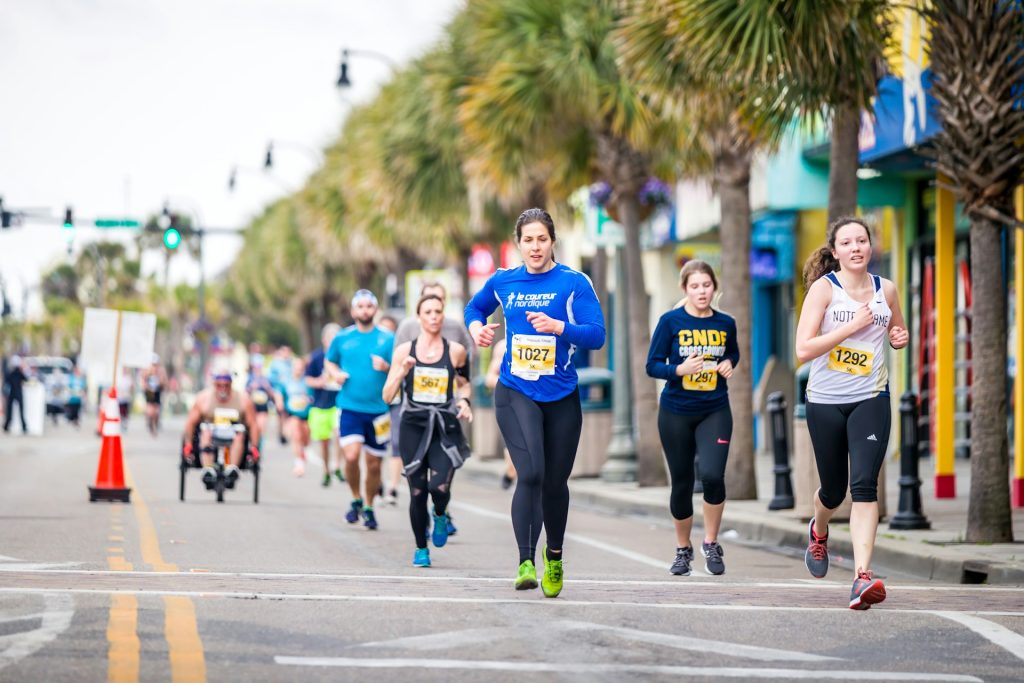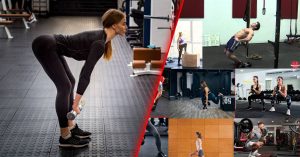Your journey to marathon glory is shaped not just by the miles under your feet but also by the strength you build away from the track. Let’s dive deep into the marathon training exercises that promise to take your running to new heights.
Table of the contents
MORE keyboard_double_arrow_down LESS keyboard_double_arrow_up
The Essential Role of Strength Training
In general, strength training is good for your body. However, the benefits of strength training is vast. It helps make your bones and muscles strong and lean. It also makes it easier to control your weight and deal with chronic conditions. For runners, adding strength training to your routine can really improve how you run. Here’s why.
1. Increases running efficiency
Good runners don’t waste energy, so they can run longer and faster. Strong muscles mean your body doesn’t get tired quickly when you exercise. Runners with strong core muscles usually have better form. Instead of using energy to stabilize muscles while running, you can use that energy to run farther or faster.
2. Lowers risk of injury
Getting injured and having to stop running is tough. Strength training can lower your chance of getting injured because strong muscles can absorb some of the force that might hurt your joints. For runners, a strong core can prevent overuse injuries in the lower back, and strong leg muscles protect the knees.
3. Helps to lose weight
Many runners find they run faster when they are leaner, and extra weight can make them feel slow. While it’s not guaranteed, having more muscle helps your body burn more calories, making it easier to lose or maintain weight.
Furthermore, take a look at this Instagram post by a running coach where she discusses about the importance of strength training for marathon runners:
The Best Marathon Training Exercises

Now that you know why strength training is important for marathon runners, let’s take a look at what type of marathon training exercises you should focus on.
Squats
The squat is at the top of out list for marathon training exercises. This is because it works many muscles important for running, including glutes, hamstrings, quads, adductors, hip flexors, calves, and core. It’s a complete workout for marathon strength training. Here’s a simple guide for a basic squat:
- Stand with feet a bit wider than hip-width apart, toes slightly turned out.
- Hold a weight to your chest, elbows together, shoulders back, chest up, and look straight ahead.
- Engage your core, bend your knees and hips, and sit back until thighs are parallel to the floor.
- Use your glutes to push back up to the starting position.
- Repeat as needed.
Different squat variations slightly change the muscles worked, and doing squats one leg at a time helps fix imbalances. Try these variations:
- Resistance band squats
- Wall-sits
- Single-leg squats
- Bulgarian split squats
- Jump squats (good for raising your heart rate)
- Isometric squats
- Lateral squat walks with a resistance band
- Sumo squats
You can do these with just your body weight or add resistance with dumbbells or kettlebells.
Lunges
The next on our list for marathon training exercises is Lunges. The lunge is a great exercise for fixing muscle imbalances and reducing the risk of injury because it’s a unilateral exercise. Since running involves a one-sided movement, lunges are a beneficial addition to your weight-lifting routine.
Here’s how to do a basic reverse lunge:
- Stand tall with feet shoulder-width apart, chest up, core engaged, and look straight ahead.
- Take a big step back with your right foot, placing the ball of your foot on the floor behind you.
- Bend both knees until they reach 90 degrees, with your right knee just above the ground and your left thigh parallel to the floor.
- Push off your back foot and return to the starting position.
- Repeat as needed.
Lunges work your glutes, quadriceps, hamstrings, calves, and core. There are various lunge variations for a complete lower-body workout:
- Side lunges
- Jumping lunges
- Forward lunges
- Walking lunges (forward and backward)
- Curtsey lunges
You can add weight to these exercises and incorporate upper body work, like overhead presses or lateral raises, to make it a full-body exercise.
Deadlifts
Deadlifts are important for strengthening your hamstrings and glutes. If you’re new to deadlifts, start with a Romanian deadlift as deadlifts can be tricky due to their technique.
Here’s how to do a Romanian deadlift:
- Practice your deadlift technique in the mirror before adding weight. Keep your back straight and avoid hunching over to prevent unnecessary pressure on your back. Focus on feeling the work in your hamstrings, not your lower back.
- Hold a dumbbell in each hand.
- Stand with feet hip-width apart, slightly bending your knees, with dumbbells at your thighs.
- Keep your back flat and hinge at your hips, bringing the dumbbells to your shins. It’s not a squat; your knees bend slightly. Your upper body should be parallel to the floor when the dumbbells are at your shins.
- Engage your core and return to the starting position, following through with your hips and squeezing your glutes.
- Repeat for the desired number of reps.
Variations to try for more advanced versions:
- Deficit deadlifts
- Single-leg deadlifts
Hip Thrusters
Now, let’s target those glutes with hip thrusters. They’re similar to glute bridges, but with a twist in position. Hip thrusters challenge you with an elevated upper body, providing an increased range of motion and hip flexion.
Here’s how to do hip thrusters:
- Place a bench or plyometric box behind you.
- Sit on the floor and place your upper back or the center of your shoulder blades against the bench or plyometric box.
- Bend your knees and put your feet flat on the floor at hip-width apart.
- Squeeze your glutes, engage your core, and lift your hips toward the ceiling until fully extended. Keep your neck relaxed, and let your gaze move naturally with the hip extension.
- Continue to squeeze your glutes and hold the bridge position for a second or two.
- Slowly lower your hips back down to the starting position.
- Repeat for the desired number of reps.
To increase difficulty, add weight. Place a dumbbell or kettlebell in the center of your hips and hold it with your hands.
Variations to try for a well-rounded workout:
- Single-legged glute bridges
- Resistance band bridges or thrusters
- Marching glute bridges
Calf Raises
To work on your calves, you’ll need a step or stair to extend the range of motion. You can also add resistance by holding dumbbells in each hand.
Here’s how to do calf raises:
- Stand with the balls of your feet on the edge of a step.
- Lower your heels down as far as possible below the step.
- Reverse the movement and push yourself up on your toes as high as you can, pausing at the top.
- Repeat for the desired number of reps.
For added resistance, hold dumbbells in either hand.
Variations to target different parts of the calf:
- Seated calf raises
- Single-leg calf raises
- Farmer’s walk on tiptoes
Push-Ups
It’s important to include upper-body and core exercises in your strength training routine. Push-ups are a great bodyweight exercise that enhances upper body strength and can be done anywhere.
Here’s how to do push-ups:
- Lie on your stomach, with palms on the ground lined up on either side of your chest, and feet hip-width apart.
- Push through your hands, extending your elbows to raise yourself up, keeping your body straight like a board.
- Lower yourself down in a controlled manner, bending your elbows until your body is barely above the ground.
- Repeat for the desired number of reps.
For progression, try these variations:
- Wall push-ups (for beginners)
- Kneeling push-ups
- Push-ups with hands on a bench
- Spiderman push-ups
- Clapping push-ups
- Single-arm push-ups (for advanced levels)
Rows
To balance out your workout, it’s crucial to strengthen your back, and rows are an excellent exercise that can enhance your running posture.
Here’s how to do rows:
- Hold a dumbbell in each hand, palms facing in, and hands by your sides.
- Bend at the waist, keeping your back completely straight and your torso almost parallel to the floor.
- Pull the dumbbells up to your chest, bending your elbows behind you.
- Hold this position briefly and lower the dumbbells with control back to your starting position.
- Repeat for the desired number of reps.
Variations to add diversity to your routine:
- Unilateral rows (work one arm at a time, then switch)
- Gorilla rows
- Suspension rows
- Isometric rows
Planks
To ensure a complete workout, it’s crucial to strengthen your core. This is why the last one on our list for marathon training exercises is planks. Planks are excellent because they engage your core, upper body, and lower body. Here’s how to do a full plank:
- Lie face down on the floor, hands on either side next to your chest, elbows back, and palms facing down as if preparing for a push-up.
- Engage your core and push yourself into the full plank position, forming a straight line from head to toe.
- Your hands, wrists, elbows, and shoulders should be in a straight line, shoulder-width apart, and your weight distributed between your arms and toes.
- Adjust the difficulty by bringing your feet closer together for more challenge or further apart for added stability.
- Hold this position for the desired amount of time.
Variations to spice up your routine:
- Elbow plank
- Side plank
- Body saw plank
- Suspension plank
- Up-down plank
- Resistance band leg raise plank
Incorporate these eight marathon strength training exercises into your routine for injury-free race day preparation. Whether you work with a personal trainer or go solo, adding strength training will contribute to optimal performance and success
Integrating Strength Workouts Into Your Running Routine

The harmony between running and strength training is delicate. The key lies in the balance. Here’s how to strike it:
- Frequency: Aim for two to three sessions per week. This cadence nurtures strength gains without impeding your running recovery.
- Timing: Schedule your strength sessions on non-consecutive days. This allows your muscles to recover and grow stronger.
- Complement, Don’t Compete: Place these workouts on lighter running days or use them as a bridge between intense run sessions. This ensures they complement rather than compete with your running goals.
With the why and how mapped out, let’s dive into the what. What tools will you need on this journey?
Your Strength Training Starter Kit
Embarking on strength training can feel like entering a new world, filled with an arsenal of equipment. But fear not; starting is simpler than it seems:
- Bodyweight Exercises: The foundation of strength training. Moves like squats, push-ups, and lunges require no equipment and offer a robust introduction.
- Dumbbells and Kettlebells: As you progress, these tools add resistance, amplifying your strength gains.
- Resistance Bands: Portable and versatile, they provide resistance without the bulk, ideal for runners on the go.
Actionable Tips for Marathon Training Success

Embarking on your marathon training journey requires more than just lacing up your running shoes and hitting the pavement. It demands a commitment to strengthening your body from the core outwards. Here’s how to seamlessly integrate strength training into your marathon regimen for unprecedented success:
- Begin your strength training journey with lighter weights and simpler exercises. Gradually increase the intensity and complexity to challenge your muscles without risking injury.
- Regularity in your strength training routine is crucial. Aim to incorporate strength exercises two to three times a week to steadily build muscle and endurance.
- Improvement in running performance and overall health won’t happen overnight. Be patient and persistent with your training, and over time, you’ll see significant gains in speed, power, and resilience.
Wrapping Up
As you delve into the world of strength training and various marathon training exercises, remember that it’s an essential component of your marathon preparation, not an optional add-on.
The foundation you build with exercises like squats, lunges, deadlifts, push-ups, rows, and planks will serve you not just in your upcoming race but in all your future endeavors as a runner. So, are you ready to start your journey in terms of strength training for runners?
Key Points
- Gradually increase weekly mileage up to 50 miles over four months before a marathon.
- Aim for three to five runs per week at a relaxed pace, where conversation is possible.
- Strength training is essential for marathon preparation, focusing on squats, lunges, deadlifts, calf raises, and core exercises like planks.
- Incorporate exercises that target key muscle groups relevant to running and improve core strength and balance.
- Before a marathon, opt for light running or dynamic stretching exercises to manage pre-race jitters and warm up the body.
- Marathon runners should include 2-3 weekly strength training sessions for legs to enhance muscle endurance, power, and prevent injuries.
- Balancing running with targeted strength training exercises ensures a comprehensive preparation for marathon success.
FAQs
What Is Proper Training for a Marathon?
Proper training for a marathon involves gradually increasing your weekly mileage up to 50 miles over the four months leading up to the race day.
Aiming for three to five runs per week at a relaxed pace is recommended for beginning marathoners. The key is to run at a pace that allows you to comfortably carry on a conversation, ensuring most of your runs build endurance without overexertion.
How Do You Strength Train for a Marathon?
Strength training for a marathon should focus on exercises that target key muscle groups relevant to running. This includes:
- Squats: To build lower body strength.
- Lunges: To improve balance and correct muscle imbalances.
- Deadlifts: For posterior chain strength, crucial for propulsion.
- Calf Raises: To enhance leg endurance and power.
Incorporating core-strengthening exercises like planks and single-leg exercises is also vital. A favorite combination is the squat and row, which targets multiple muscle groups simultaneously.
What Exercises Should I Do Before a Marathon?
Before a marathon, more experienced runners might opt for a light run to stay loose and keep muscles engaged. For those dealing with pre-race jitters, light jogging and dynamic stretching exercises can be beneficial. These activities slightly increase your heart rate and warm up your body, preparing you for the race without causing fatigue.
Should Marathon Runners Train Legs?
Yes, marathon runners should definitely include leg training in their regimen. While running itself builds leg strength, targeted strength training adds another layer of muscle endurance and power.
It’s recommended to complete two to three strength training sessions per week focused on the legs. This not only enhances running performance but also helps in preventing injuries by ensuring balanced muscle development.

ABOUT THE AUTHOR
Follow Valen Steven for a dose of fitness enthusiasm, evidence-based advice, and a roadmap to achieving your health and wellness goals.
Subscribe to our Newsletter
Dive into a world of fitness and wellness with our exclusive newsletter! Sign up now and receive weekly power-packs of fitness wisdom




